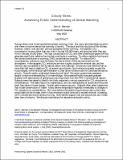| dc.contributor.author | Sterman, John D | |
| dc.contributor.author | Sweeney, Linda Booth | |
| dc.date.accessioned | 2025-04-09T14:43:01Z | |
| dc.date.available | 2025-04-09T14:43:01Z | |
| dc.date.issued | 2002-06 | |
| dc.identifier.uri | https://hdl.handle.net/1721.1/159067 | |
| dc.description.abstract | Surveys show that most Americans believe global warming is real. But many advocate delaying action until there is more evidence that warming is harmful. The stock and flow structure of the climate, however, means “wait and see” policies guarantee further warming. Atmospheric CO2 concentration is now higher than any time in the last 420,000 years, and growing faster than any time in the past 20,000 years. The high concentration of CO2 and other greenhouse gases (GHGs) generates significant radiative forcing that contributes to warming. To reduce radiative forcing and the human contribution to warming, GHG concentrations must fall. To reduce GHG concentrations, emissions must fall below the rate at which GHGs are removed from the atmosphere. Anthropogenic CO2 emissions are now roughly double the removal rate, and the removal rate is projected to fall as natural carbon sinks saturate. Emissions must therefore fall by more than half even to stabilize CO2 at present record levels. Such reductions greatly exceed the Kyoto targets, while the Bush administration's Clear Skies Initiative calls for continued emissions growth. Does the public understand these physical facts? We report experiments assessing people's intuitive understanding of climate change. We presented highly educated graduate students with descriptions of greenhouse warming drawn from the IPCC's nontechnical reports. Subjects were then asked to identify the likely response to various scenarios for CO2 emissions or concentrations. The tasks require no mathematics, only an understanding of stocks and flows and basic facts about climate change. Overall performance was poor. Subjects often select trajectories that violate conservation of matter. Many believe temperature responds immediately to changes in CO2 emissions or concentrations. Still more believe that stabilizing emissions near current rates would stabilize the climate, when in fact emissions would continue to exceed removal, increasing GHG concentrations and radiative forcing. Such beliefs support “wait and see” policies, but violate basic laws of physics. We discuss implications for education and public policy. | en_US |
| dc.language.iso | en | |
| dc.publisher | Wiley | en_US |
| dc.relation.isversionof | 10.1002/sdr.242 | en_US |
| dc.rights | Article is made available in accordance with the publisher's policy and may be subject to US copyright law. Please refer to the publisher's site for terms of use. | en_US |
| dc.source | Author | en_US |
| dc.title | Cloudy skies: assessing public understanding of global warming | en_US |
| dc.type | Article | en_US |
| dc.identifier.citation | Sterman, J.D. and Sweeney, L.B. (2002), Cloudy skies: assessing public understanding of global warming. Syst. Dyn. Rev., 18: 207-240. | en_US |
| dc.contributor.department | Sloan School of Management | en_US |
| dc.relation.journal | System Dynamics Review | en_US |
| dc.eprint.version | Author's final manuscript | en_US |
| dc.type.uri | http://purl.org/eprint/type/JournalArticle | en_US |
| eprint.status | http://purl.org/eprint/status/PeerReviewed | en_US |
| dc.date.updated | 2025-04-09T14:36:46Z | |
| dspace.orderedauthors | Sterman, JD; Sweeney, LB | en_US |
| dspace.date.submission | 2025-04-09T14:36:48Z | |
| mit.journal.volume | 18 | en_US |
| mit.journal.issue | 2 | en_US |
| mit.license | PUBLISHER_POLICY | |
| mit.metadata.status | Authority Work and Publication Information Needed | en_US |
